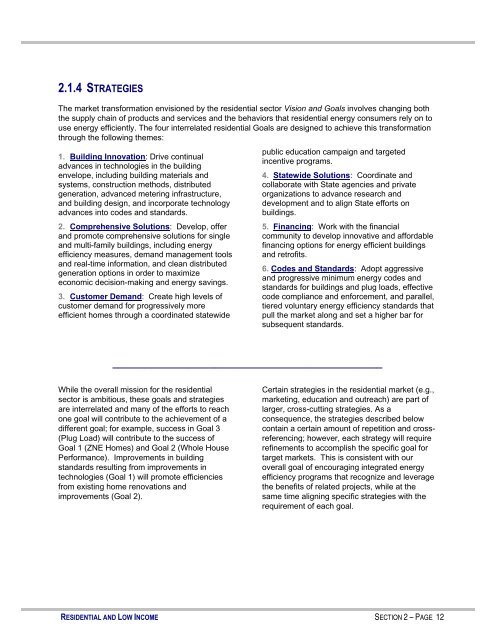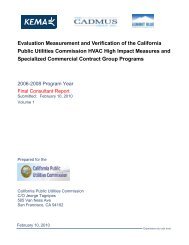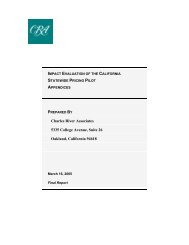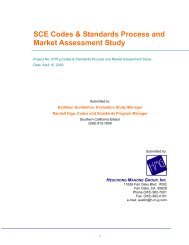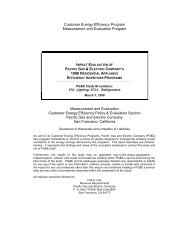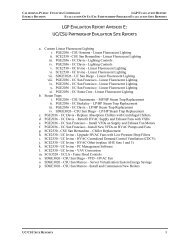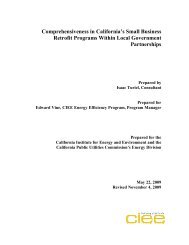Long Term Energy Efficiency Strategic Plan - California Public ...
Long Term Energy Efficiency Strategic Plan - California Public ...
Long Term Energy Efficiency Strategic Plan - California Public ...
Create successful ePaper yourself
Turn your PDF publications into a flip-book with our unique Google optimized e-Paper software.
2.1.4 STRATEGIES<br />
The market transformation envisioned by the residential sector Vision and Goals involves changing both<br />
the supply chain of products and services and the behaviors that residential energy consumers rely on to<br />
use energy efficiently. The four interrelated residential Goals are designed to achieve this transformation<br />
through the following themes:<br />
1. Building Innovation: Drive continual<br />
advances in technologies in the building<br />
envelope, including building materials and<br />
systems, construction methods, distributed<br />
generation, advanced metering infrastructure,<br />
and building design, and incorporate technology<br />
advances into codes and standards.<br />
2. Comprehensive Solutions: Develop, offer<br />
and promote comprehensive solutions for single<br />
and multi-family buildings, including energy<br />
efficiency measures, demand management tools<br />
and real-time information, and clean distributed<br />
generation options in order to maximize<br />
economic decision-making and energy savings.<br />
3. Customer Demand: Create high levels of<br />
customer demand for progressively more<br />
efficient homes through a coordinated statewide<br />
public education campaign and targeted<br />
incentive programs.<br />
4. Statewide Solutions: Coordinate and<br />
collaborate with State agencies and private<br />
organizations to advance research and<br />
development and to align State efforts on<br />
buildings.<br />
5. Financing: Work with the financial<br />
community to develop innovative and affordable<br />
financing options for energy efficient buildings<br />
and retrofits.<br />
6. Codes and Standards: Adopt aggressive<br />
and progressive minimum energy codes and<br />
standards for buildings and plug loads, effective<br />
code compliance and enforcement, and parallel,<br />
tiered voluntary energy efficiency standards that<br />
pull the market along and set a higher bar for<br />
subsequent standards.<br />
__________________________________________________<br />
While the overall mission for the residential<br />
sector is ambitious, these goals and strategies<br />
are interrelated and many of the efforts to reach<br />
one goal will contribute to the achievement of a<br />
different goal; for example, success in Goal 3<br />
(Plug Load) will contribute to the success of<br />
Goal 1 (ZNE Homes) and Goal 2 (Whole House<br />
Performance). Improvements in building<br />
standards resulting from improvements in<br />
technologies (Goal 1) will promote efficiencies<br />
from existing home renovations and<br />
improvements (Goal 2).<br />
Certain strategies in the residential market (e.g.,<br />
marketing, education and outreach) are part of<br />
larger, cross-cutting strategies. As a<br />
consequence, the strategies described below<br />
contain a certain amount of repetition and crossreferencing;<br />
however, each strategy will require<br />
refinements to accomplish the specific goal for<br />
target markets. This is consistent with our<br />
overall goal of encouraging integrated energy<br />
efficiency programs that recognize and leverage<br />
the benefits of related projects, while at the<br />
same time aligning specific strategies with the<br />
requirement of each goal.<br />
RESIDENTIAL AND LOW INCOME SECTION 2 – PAGE 12


